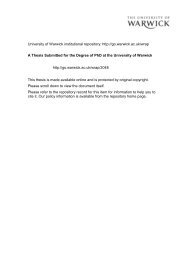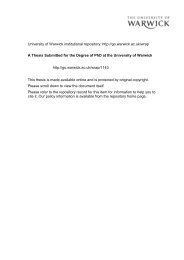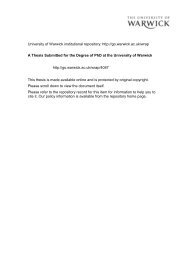From Page to Screen - WRAP: Warwick Research Archive Portal ...
From Page to Screen - WRAP: Warwick Research Archive Portal ...
From Page to Screen - WRAP: Warwick Research Archive Portal ...
Create successful ePaper yourself
Turn your PDF publications into a flip-book with our unique Google optimized e-Paper software.
Coser, Kadushin and Powell describe, and the attempt <strong>to</strong> use the possibilities of<br />
electronic publishing, such as Alternative X, <strong>to</strong> cut out the later by direct publishing and<br />
encourage the first by peer review and instant feedback on text by a close community of<br />
fellow writers and readers.<br />
In the second part ofthis chapter I will focus on projects which approach the question<br />
of collaboration in a very direct and practical way, by setting up facilities for a group of<br />
authors <strong>to</strong> work in parallel on, in principle, an evergrowing and everchanging literary<br />
project. These collaborations, not unheard of but rare in print, have developed in<strong>to</strong> an<br />
important part of the literary internet scene" and can have different emphases: a small<br />
number of authors or large-scale collaborations, crediting the individual contributions of<br />
their respective authors or anonYmous, heavily edited or open for changes and additions.<br />
Another possible categorisation, one which is proposed by the "Collaboration on the<br />
Web" website" and which I like <strong>to</strong> adopt is a categorisation by structure, and more<br />
precisely between a linear and a non-linear structure. Despite the vagueness and<br />
inadequacies of the terminology of linear and non-linear when used <strong>to</strong> distinguish<br />
hypertext from print (see chapter 2), it is, in this clearly defined context, a valid and<br />
useful distinction.<br />
In a linear structure, one initial node (e.g. a paragraph of a short s<strong>to</strong>ry or a chapter of a<br />
novella) is followed by only one other, which in turn is continued by just one; the<br />
collaboration is strictly temporal and linearly accumulating. In a non-linear arrangement,<br />
often organised in a branching out tree-structure, contribu<strong>to</strong>rs are free <strong>to</strong> add <strong>to</strong> an<br />
already existing branch or create a new one, therefore offering a greater flexibility as <strong>to</strong><br />
where <strong>to</strong> add a link, but also of developing any branch locally in more unexpected<br />
directions. Cross-referencing between nodes is often possible, and contributions are<br />
more spatially located since they affect the narrative development only locally. These are<br />
the hyperfictions, claim the authors of "Collaboration on the Web", which "take full<br />
advantage oftheir hypertext and collaborative styles {...and} are true hypcrfiction'Y .<br />
82 They often use a combination of eMail and the WWW: contributions are mailed <strong>to</strong> the<br />
edi<strong>to</strong>r/edi<strong>to</strong>rial board/facilita<strong>to</strong>r and then selected, edited and finally uploaded <strong>to</strong> the project's webpages<br />
(the selection and editing powers do vary from project <strong>to</strong> project).<br />
B3 http://www.innotts.co.uk/-leo/collwr.html.,<br />
84http://www.innotts.co.uk/-leo/collwr.html.<br />
Chapter 4 - page 157





